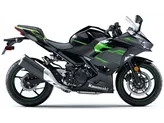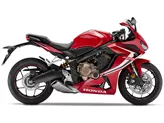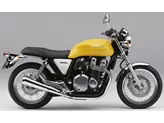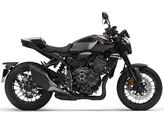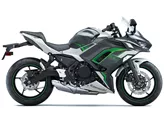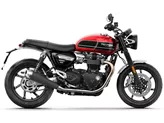Kawasaki Z900 RS 2018 vs. Kawasaki Ninja 650 2017

Kawasaki Z900 RS 2018

Kawasaki Ninja 650 2017
Visão geral - Kawasaki Z900 RS 2018 vs Kawasaki Ninja 650 2017
The Kawasaki Z900 RS 2018 and the Kawasaki Ninja 650 2017 are both popular models from Kawasaki, but they have some key differences in terms of specifications and strengths.
Starting with the technical specifications, the Kawasaki Z900 RS 2018 is equipped with an inline four-cylinder engine with a displacement of 948cc. It produces a powerful 111 HP and 98.6 Nm of torque. The engine has a compression ratio of 10.8 and is fueled by an injection system. The Z900 RS has a liquid-cooled system and features a 4-valve DOHC configuration. It has a steel frame and a rake of 65 degrees. The front suspension consists of a telescopic upside-down fork with a diameter of 41mm, while the rear suspension is a swingarm with a monoshock and adjustable preload and recovery. The Z900 RS has dual disc brakes with a diameter of 300mm and four-piston calipers. It also comes with advanced rider assistance systems such as ABS, ride-by-wire, and traction control. The bike weighs 215 kg and has a fuel tank capacity of 17 liters.

Kawasaki Z900 RS 2018
On the other hand, the Kawasaki Ninja 650 2017 is powered by an inline twin-cylinder engine with a displacement of 649cc. It produces 68.2 HP and 65.7 Nm of torque. The engine has a compression ratio of 10.8 and is also fueled by an injection system. Like the Z900 RS, it has a liquid-cooled system and features a 4-valve DOHC configuration. The Ninja 650 has a steel frame with a rake of 65.5 degrees. The front suspension consists of a telescopic fork with a diameter of 41mm, while the rear suspension is a swingarm with a monoshock and adjustable preload. It has dual disc brakes with a diameter of 300mm and dual-piston calipers. The Ninja 650 is equipped with ABS as a rider assistance system. It weighs 193 kg and has a fuel tank capacity of 15 liters.
In terms of strengths, the Kawasaki Z900 RS 2018 offers a powerful and smooth engine, a stylish appearance, a comfortable seating position, and easy handling. It is not nervous or heavy, providing a balanced ride. On the other hand, the Kawasaki Ninja 650 2017 is praised for its sporty chassis, playful and fun handling, excellent brakes, and an elegant appearance reminiscent of the ZX-10R. It also has a durable engine.

Kawasaki Ninja 650 2017
However, both models have their weaknesses. The Kawasaki Z900 RS 2018 lacks a gear shift assistant, making gear changes less convenient. It is also heavier than other retro bikes in its class and has a seat that may be too soft for long rides. Additionally, it lacks wind protection. On the other hand, the Kawasaki Ninja 650 2017 has a relatively quiet exhaust sound as standard and the engine may exhibit slight vibrations.
In conclusion, the Kawasaki Z900 RS 2018 and the Kawasaki Ninja 650 2017 are both impressive models from Kawasaki, each with its own strengths and weaknesses. The Z900 RS offers a more powerful and comfortable riding experience, while the Ninja 650 provides a sportier and more playful ride. Ultimately, the choice between the two will depend on the rider's preferences and priorities.
Especificações técnicas Kawasaki Z900 RS 2018 em comparação com Kawasaki Ninja 650 2017
Prós e contras em comparação
Prós e contras em comparação
Kawasaki Z900 RS 2018

Os seus quatro cilindros são suaves como a seda e fornecem potência suficiente para o fazer sorrir debaixo do capacete. É também muito fácil de deslocar, o que a torna uma excelente moto para o dia a dia e uma moto icónica e divertida para o fim de semana. O visual encontra o equilíbrio perfeito entre o design clássico e os detalhes modernos para formar um conjunto retro coerente que é também um tributo digno à história da Kawasaki. É uma excelente naked bike com um visual elegante.
Kawasaki Ninja 650 2017

A Ninja 650 é um selo firme da sua antecessora (Er-6f). O motor dominou bem a barreira do Euro 4 e oferece 68 cv muito úteis, o chassis é simplesmente fantástico para esta classe e a redução de peso de 18(!) quilos em comparação com a ER-6f justifica acenos de cabeça reverentes.
Comparação de preços Preço médio de mercado Kawasaki Z900 RS vs Kawasaki Ninja 650
There are a few key differences between a Kawasaki Z900 RS 2018 and a Kawasaki Ninja 650 2017. In terms of price, the actual average price of a Kawasaki Z900 RS 2018 is about 86% higher. A Kawasaki Z900 RS 2018 experiences a loss of 6.040 BRL in one year and 7.180 BRL in two years of ownership. This is offset by a loss of 2.580 BRL and 3.330 BRL for a Kawasaki Ninja 650 2017. Compared to Kawasaki Ninja 650 2017 there are more Kawasaki Z900 RS 2018 bikes available on the 1000PS.de Marketplace, specifically 28 compared to 7. It takes less time to sell a Kawasaki Ninja 650 with 96 days compared to 154 days for the Kawasaki Z900 RS. Since model year 2018 1000PS.de editors have written 26 reviews for the Kawasaki Z900 RS and 20 reviews for the Kawasaki Ninja 650 since model year 2017. The first review for the Kawasaki Z900 RS was published on 06/09/2017 and now has more than 63.700 views. This compares to more than 79.600 views for the first review on Kawasaki Ninja 650 published on 04/10/2016.





